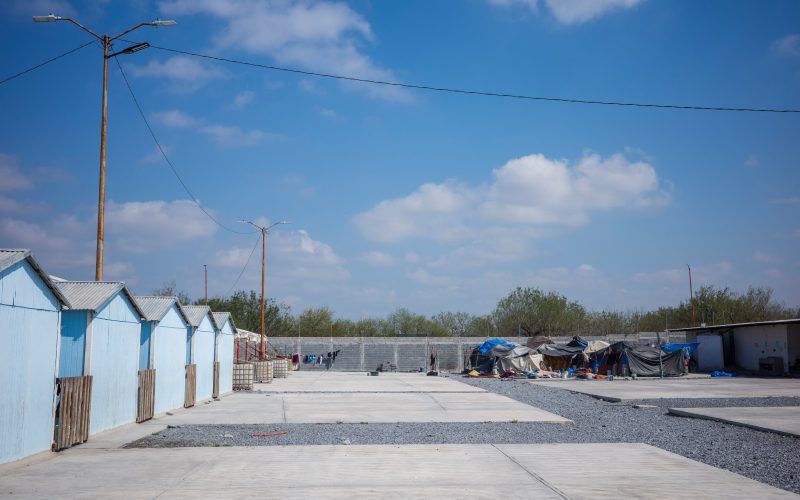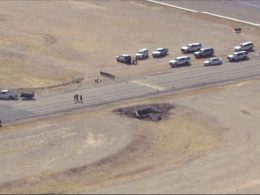By Aline Corpus Simerman, Gaige Davila, Angela Kocherga, and Alfredo Corchado | Edited by Dianne Solis
JU REZ CIUDAD One month after President Donald Trump vowed mass deportations on Day 1, the Mexican government’s mega shelters for deportees near the border remain largely empty.
Trump’s pledge to begin the biggest deportation operation in American history has so far failed, as evidenced by the events here and in other border cities to the west, such as Tijuana, and east, such as Reynosa. Trump targeted an estimated 11 million undocumented people during his campaign.
Mexican border officials, especially those in Ciudad Jurez, seem happy that the number of deportees hasn’t increased yet.
After touring a vast, deserted tent camp that may house 2,500 deportees, Secretary of Welfare Ariadna Montiel Reyes stated, “We hope there won’t be a large repatriation.” In a process commonly referred to as repatriation, the federal agency is responsible for providing services to Mexicans who have returned to their homeland.
During her daily press conference, Mexican President Claudia Sheinbaum stated that approximately 2,000 migrants from Mexico have entered government-run shelters thus far. According to Sheinbaum, a total of 13,455 migrants had been sent back to Mexico. More than 2,970 migrants from nations other than Mexico, such as Cuba and Venezuela, are among those involved in a significant negotiation, according to Mexican officials.
The Mexican federal government set up tents south of the border wall at Ciudad Ju rez to house Mexican deportees from the United States.El Paso Times/Puente News Collaborative/Omar Ornelas photo
According to Ariel G. Ruiz Soto, a senior policy analyst at the independent Migration Policy Institute, the number of deportees deported to Mexico in the past month exceeded the number transferred in the preceding four weeks of President Joe Biden’s administration.
According to Ruiz Soto, who has studied data from both the United States and Mexico, deportations have subsequently steadied, if not actually decreased, in comparison to the first ten days of the Trump administration. In reference to detention space, he stated that this has a lot to do with the actual difficulties that ICE [U.S. Immigration and Customs Enforcement] is having due to limited capacity in the interior.
ICE has consistently informed Congress that it lacks the resources necessary to hold all of the undocumented immigrants Trump has pledged to apprehend.Tom Homantold, the Border Czar, told CNN Sunday Since we have a lot of crooks to track down, I’m not thrilled with the stats. raising the number of teams and (raising) the targeting is what we are currently discussing. We have much to do.
Questions were not answered by the Department of Defense, ICE, or CBP.
Nogales
According to Alma Cota de Ya ez, executive director of Fundaci n Empresarial Sonorense, or FESAC, a nonprofit organization dedicated to border development and immigrant help, shelters in Nogales, Arizona, across from Nogales, are either vacant or have few migrants. At a gathering of charitable organizations in Mexico City, Cota de Yaez stated, “We’re not seeing any chaos in our community.”
However, using U.S.-Mexico history as a guide, concerns still exist. According to historians in the book Decade of Betrayal, around 1 million Mexicans and their children born in the United States were deported during the so-called great repatriation, which took place between 1929 and 1939.Known by the racist moniker Operation Wetback, the U.S. government deported an estimated hundreds of thousands of people and their children born in the United States in 1954. In the streets of cities, particularly those with sizable Latino populations, both operations caused widespread terror and worry.
The scars of humiliation are still visible and raw on both sides of the border decades later. Mexico is therefore not taking any chances with regard to sentiment and practical implementation.The government’s campaign slogan is “Mexico Hugs You,” or “Mexico te abraza.”
The Ju rez shelter has gray and blue bedding inside the camp, while the orange, pink, and turquoise portable restrooms outside provide bursts of color. A life-size statue of Catholic Pope Francis, a champion of immigrants, with an outstretched hand releasing a dove, is looking over the scene. A U.S.-Mexico boundary dispute was resolved when the pope’s statue was erected at El Punto, next to the ancient Chamizal Park, about ten years ago.
The massive tent shelter for Mexican nationals deported by the Trump administration is located in Ciudad Jurez, with a statue of Pope Francis overlooking it. El Punto, where Pope Francis held a Mass in 2016, is where the shelter is located on the border.Angela Kocherga/Puente News Collaborative took the picture.
Tijuana
Another makeshift shelter with bunk beds, showers, and a kitchen for migrants staying for one or two days has appeared in downtown Tijuana. The refuge is called Juuventud2000.
Whether in the states of Tamaulipas, Chihuahua, or Baja California, the shelter’s residents have one thing in common: they are migrants who have no other way to get refuge in the United States or valid admission using a now-defunct mobile phone app.
In the hopes that Trump’s policy might change, some Mexican migrants said they would stay in Tijuana. Concerns about overburdening border communities in the upcoming weeks and months are growing as a result. To entice migrants to return to their hometowns in the country’s interior, the Sheinbaum administration is giving out $97 debit cards.
Think of Mat as 35-year-old Ezequiel. He stated, “We are from Puebla, and there is a lot of violence there, but our hope ended when Trump took office.” My kids received threats, and we will most certainly not return.
According to migrants, some will choose to fast boat through the lake or jump the wall in Tijuana. Others travel through the neighboring city of Tecate to the east by mountain paths. Others, however, pass past vehicle checkpoints using other people’s visas.
The fees that coyotes charge in Tijuana have increased, migrants say. These crossings double costs, with prices ranging from $6,000 to $10,000. However, according to humanitarian workers at migrant organizations, coyotes are vying for business in other places, such as Ju rez, where prices have decreased as a result of declining demand.
In Tijuana, Baja California, a migrant center has tables set up to help arriving deportees.The State of Baja California provided the image.
Reynosa
Similarly, migrants are sleeping on the streets or retreating to shelters in Reynosa. About 100 individuals reside in limbo at Senda de Vida 2, one of the biggest private shelters in the city, but it can house up to 2,000 people.
Mexican nationals who were deported following ICE raids in recent weeks have sought sanctuary in Casa del Migrante Nuestra Se ora de Guadalupe, a smaller private shelter. Currently, roughly 160 migrants—mostly Mexicans—are taking refuge at the facility behind thick doors because they are concerned about the security in their home nations.
What else are the individuals present going to do? stated Kevin McNamara, executive director of 13:2 Initiative, a shelter-distributing group located in Texas.
It’s likely going to be four years before there are any meaningful pathways, he added, but perhaps they are clinging to the hope that something might work out.
On February 7, 2025, Mexican immigration police escort migrants into Reynosa, Tamaulipas, Mexico.Gaige Davila/Puente News Collaborative took the picture.
Del Rio
Ironically, the hundreds of military personnel on both sides seem to be the only significant influx of immigrants around the border. Ten thousand more national guard soldiers were dispatched by Sheinbaum to border states in Mexico. Trump’s warnings of 25% tariffs on Mexican goods, which would harm American customers, have inspired some people to help Mexican military personnel in their desperate quest for covert tunnels used for smuggling and fentanyl-bound cars headed to the United States.
In order to bolster the U.S. Border Patrol, the Trump administration has sent 1,500 more troops to the southern U.S. border, joining the 2,500 that have already been there.
Some residents of Del Rio, which is regarded as one of the safest cities in the country, are confused by the presence of some US military personnel in motels that are already packed with Texas troopers.
Just as a community member, I m not seeing them in their military uniforms, said Tiffany Burrow, who runs the nonprofit Val Verde Humanitarian Border Coalition. Off duty, I see them going to Chick-fil-A, Whataburger, or strolling up and down our Main Street. According to her, the number of migrants seeking assistance fell from roughly 89 per day in early January to zero.
A member of the U.S. National Guard on February 7, 2025, beneath the McAllen/Hidalgo International Bridge. near with the 2,500 troops already stationed near the southern U.S. border, the Trump administration has sent out an additional 1500 troops.Gaige Davila/Puente News Collaborative took the picture.
El Paso
Somewhere between the powerful economic and cultural forces that bind two countries and two border cities lies frayed nerves and confusion. Social media further agitates the public at the shelters and elsewhere. In El Paso, a county of more than 950,000 residents, more than 80% of the population is Latino. Here, it seems, everyone is suspected of being undocumented.
A recent videoshows agents wearing vests with the logos of the U.S. Border Patrol asking a group of English-speaking young men at a horse training facility about their citizenship. One armed agent demands proof.
I m a U.S. citizen, just to clarify, born in El Paso, Texas, the young man answered.
U.S. Border Patrol would not comment on the video, citing an investigation. But Border Patrol agent Orlando Marrero-Rubio said agents are not randomly asking people for immigration papers. Anti-smuggling and intelligence units carry out targeted enforcement involving a specific suspect and have a warrant, he said.
The video and people present when the agents arrived suggest otherwise. They say the men never presented a warrant to enter private property. At the horse stables, a worker named Ventura, who declined to provide his surname, summed up his emotions in Spanish about deportations.
Estamos muy tristes,Ventura said.Nos sentimos acorralados. No por los caballos, pero la migra.
[ We are very sad. We feel corralled. Not by the horses but by immigration agents. ]









